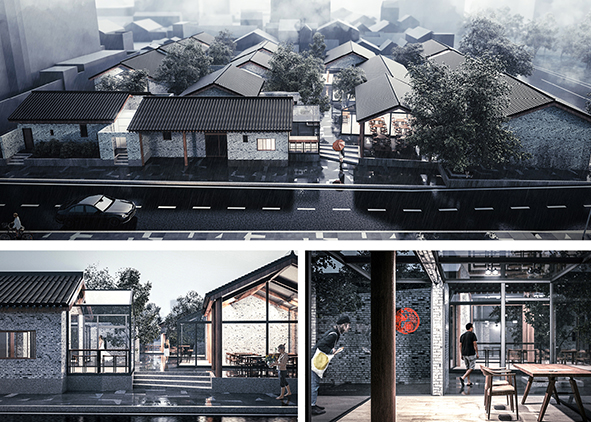Understanding Chinese Cities. Redesigning italian methods
DOI:
https://doi.org/10.19229/2464-9309/3172018Keywords:
urban morphologies, tradition, Chinese courtyard houses, regenerationAbstract
What could be the outcomes of an urban regeneration project in China nowadays? Should we really choose between ordinary districts composed of tall, anonymous buildings or gated communities closed into inner villages and dominated by fake restorations in the traditional Chinese style? In the contemporary Chinese society, with the economic system becoming more and more complex along with the new rules concerning ownership, all these novelties demand designers and decision-makers to find a third way, namely, the new sustainable architecture that is designed based on the typological and morphological fundamentals of the city. That is also a way for the necessary renovation of typological and morphological studies into the architectural and urban worldwide culture towards much less rigid and much more flexible ideas of what a type is. The paper describes the teaching experience of two architectural design professors (one Chinese and one Italian) in Nanjing at SEU Arch during the last four years.
Downloads
Article Metrics Graph
References
Brook, D. (2014), A History of Future cities, Norton, New York/London.
Caniggia, G. (1963), Lettura di una città – Como, Centro Studi di Storia Urbanistica, Roma.
Chen, W. and Gazzola, L. (2013), Comparative study on the city walls of Nanjing and Rome, Southeast University Press, EdilStampa ANCE, Nanjing-Roma.
Chen, F. and Thwaites, K. (2013), Chinese Urban Design – The typomorphological Approach, Ashgate, Farnham Burlington.
Deng, H. (2016), “Rossi or Muratori?”, in Viewpoints | Discussion of topical issues in urban morphology at Urban Morphology, Journal online, vol. 20.1.
Li, S. (2014), Understanding the Chinese city, SAGE, Los Angeles, London, New Dehli, Singapore.
Liu, D. (2014), Ancient Qingming river, Tongji University Press, Shanghai.
Petruccioli, A. (2007), After Amnesia – Learning from the Islamic Mediterranean Urban Fabric, ICAR, Bari.
Rossi, A. (1966), L’architettura della città, Marsilio, Venezia.
Rowe, P. G., Forsyth, A. and Kan, H. Y. (2016), China’s Urban communities – Concepts, contexts, and wellbeing, Birkhäuser, Basel.
Salat, S., Labbé, F. and Nowacki, C. (2011), Cities and Forms – on sustainable Urbanism [english edition], Hermann Éditeurs des Sciences et des Arts, Paris.
Trisciuoglio, M. (2017), “The Wall and the Column”, in Trisciuoglio, M. (ed.), Writing Morphologies, Politecnico di Torino, MAECI, Torino, JianLing Graphic, Nanjing.
Trisciuoglio, M. and Dong, Y. (2017), “Towards a Permuting Idea of Architectural Types: The Italian Typo- Morphological Approach and the Chinese City”, in JIANZHUSHI, n. 190, December, pp. 22-30.
Trisciuoglio, M., Jiang, L., Bao, L. and Zhan, Y. (2017), “Typological Permanencies and Urban Permutations – Design Studio of Re-generation”, in Hehuatang Area, Nanjing, Southeast University Press, Nanjing.
Weng, X. (2017), “Counter-mythologies, or Tales of Our Time”, introduction to the catalogue, Tales of our time, Solomon Guggenheim Museum, New York.
Whitehand, J. W. R. and Gu, K. (2007), “Urban conservation in China: Historical development, current practice and morphological approach”, in Town Planning Review, vol. 78, issue 5, pp. 643-670.

Downloads
Published
How to Cite
Issue
Section
License
This Journal is published under Creative Commons Attribution Licence 4.0 (CC-BY).
License scheme | Legal code
This License allows anyone to:
Share: copy and redistribute the material in any medium or format.
Adapt: remix, transform, and build upon the material for any purpose, even commercially.
Under the following terms
Attribution: Users must give appropriate credit, provide a link to the license, and indicate if changes were made; users may do so in any reasonable manner, but not in any way that suggests the licensor endorses them or their use.
No additional restrictions: Users may not apply legal terms or technological measures that legally restrict others from doing anything the license permits.
Notices
Users do not have to comply with the license for elements of the material in the public domain or where your use is permitted by an applicable exception or limitation.
No warranties are given. The license may not give users all of the permissions necessary for their intended use. For example, other rights such as publicity, privacy, or moral rights may limit how you use the material.


















































































